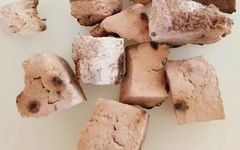Author Introduction Fuling (Poria cocos) has a sweet and bland taste, and a neutral nature. It is notably effective in promoting the discharge of dampness from the body, making it a good remedy for symptoms such as edema and difficulty urinating. The accumulation of dampness in the body often leads to various discomforts, and Fuling’s diuretic and damp-dispelling properties can help us regulate our body’s water balance and alleviate these symptoms.In addition to its diuretic and damp-dispelling effects, Fuling also has the ability to strengthen the spleen and boost qi. In TCM theory, the spleen is responsible for transformation and transportation; a deficiency in the spleen can lead to symptoms such as poor appetite, general weakness, and loose stools. By strengthening the spleen and boosting qi, Fuling can improve these discomforts caused by spleen deficiency, enhancing the body’s digestive and absorption functions, leading to better health and vitality.
Fuling (Poria cocos) has a sweet and bland taste, and a neutral nature. It is notably effective in promoting the discharge of dampness from the body, making it a good remedy for symptoms such as edema and difficulty urinating. The accumulation of dampness in the body often leads to various discomforts, and Fuling’s diuretic and damp-dispelling properties can help us regulate our body’s water balance and alleviate these symptoms.In addition to its diuretic and damp-dispelling effects, Fuling also has the ability to strengthen the spleen and boost qi. In TCM theory, the spleen is responsible for transformation and transportation; a deficiency in the spleen can lead to symptoms such as poor appetite, general weakness, and loose stools. By strengthening the spleen and boosting qi, Fuling can improve these discomforts caused by spleen deficiency, enhancing the body’s digestive and absorption functions, leading to better health and vitality. Chi Fuling (Yunnan Chuxiong)The calming and mind-stabilizing effects of Fuling should not be underestimated. In the fast-paced modern life, we often face various pressures and anxieties, leading to issues such as restlessness, insomnia, and irritability. Fuling’s calming properties can help us soothe our inner turmoil, improve sleep quality, and allow us to achieve a more tranquil and relaxed state of mind and body.Moreover, Fuling also has anti-aging effects. Some polysaccharides contained in it have antioxidant properties, which can help delay the aging process. Additionally, Fuling can enhance the body’s immune function through its immune-regulating effects, improving our resistance and promoting better health and longevity.It is worth mentioning that modern research has found that some components in Fuling also exhibit anti-tumor effects. Although its specific applications need to be guided by a physician, this discovery provides new ideas and possibilities for tumor treatment.Fuling also has a certain protective effect on the liver. It can help improve liver function and protect our liver health. The liver is an important metabolic organ in the body, and maintaining its good condition is crucial for overall health.Next, let’s discuss the classification and identification points of Fuling available in the market. Fuling is the dried sclerotium of the fungus Poria cocos, typically harvested from July to September. After being dug up, the dirt is removed, and it is piled up to “sweat” before being spread out to dry until the surface is dry, then “sweated” again, repeating several times until wrinkles appear and most of the internal moisture is lost, then it is dried in the shade, referred to as “Fuling Ge”. Alternatively, it can be processed using different methods, resulting in products that are generally classified into Fuling Ding (cubes), Fuling Pian (slices), and Fuling Juan (rolls). Below is a brief introduction to the processing methods of these three types of Fuling.
Chi Fuling (Yunnan Chuxiong)The calming and mind-stabilizing effects of Fuling should not be underestimated. In the fast-paced modern life, we often face various pressures and anxieties, leading to issues such as restlessness, insomnia, and irritability. Fuling’s calming properties can help us soothe our inner turmoil, improve sleep quality, and allow us to achieve a more tranquil and relaxed state of mind and body.Moreover, Fuling also has anti-aging effects. Some polysaccharides contained in it have antioxidant properties, which can help delay the aging process. Additionally, Fuling can enhance the body’s immune function through its immune-regulating effects, improving our resistance and promoting better health and longevity.It is worth mentioning that modern research has found that some components in Fuling also exhibit anti-tumor effects. Although its specific applications need to be guided by a physician, this discovery provides new ideas and possibilities for tumor treatment.Fuling also has a certain protective effect on the liver. It can help improve liver function and protect our liver health. The liver is an important metabolic organ in the body, and maintaining its good condition is crucial for overall health.Next, let’s discuss the classification and identification points of Fuling available in the market. Fuling is the dried sclerotium of the fungus Poria cocos, typically harvested from July to September. After being dug up, the dirt is removed, and it is piled up to “sweat” before being spread out to dry until the surface is dry, then “sweated” again, repeating several times until wrinkles appear and most of the internal moisture is lost, then it is dried in the shade, referred to as “Fuling Ge”. Alternatively, it can be processed using different methods, resulting in products that are generally classified into Fuling Ding (cubes), Fuling Pian (slices), and Fuling Juan (rolls). Below is a brief introduction to the processing methods of these three types of Fuling. Bai Fuling (Center Ding, Anhui Yuexi)Since Fuling is a major medicinal herb with a large volume used throughout the year, and most of it is harvested from July to September, it is difficult to process all of it within such a short time. Therefore, the commonly seen Fuling Ding in the market is often made by sorting “Fuling Ge” by size, moistening it, slightly steaming it, peeling it while hot, cutting it into cubes, and then dicing it. A small amount is directly cut from fresh Fuling. Fuling Ding is nearly cubical and can be classified into large Ding (10mm), medium Ding (8mm), and small Ding (6mm) based on diameter, and can also be categorized into edge Ding, whole Ding, and center Ding based on the position from which the Ding is taken.Next is Fuling Pian, which is made by sorting fresh Fuling or “Fuling Ge” by size, moistening it, slightly steaming it, and then cutting the middle part into slices approximately 5mm thick and 3cm long.
Bai Fuling (Center Ding, Anhui Yuexi)Since Fuling is a major medicinal herb with a large volume used throughout the year, and most of it is harvested from July to September, it is difficult to process all of it within such a short time. Therefore, the commonly seen Fuling Ding in the market is often made by sorting “Fuling Ge” by size, moistening it, slightly steaming it, peeling it while hot, cutting it into cubes, and then dicing it. A small amount is directly cut from fresh Fuling. Fuling Ding is nearly cubical and can be classified into large Ding (10mm), medium Ding (8mm), and small Ding (6mm) based on diameter, and can also be categorized into edge Ding, whole Ding, and center Ding based on the position from which the Ding is taken.Next is Fuling Pian, which is made by sorting fresh Fuling or “Fuling Ge” by size, moistening it, slightly steaming it, and then cutting the middle part into slices approximately 5mm thick and 3cm long.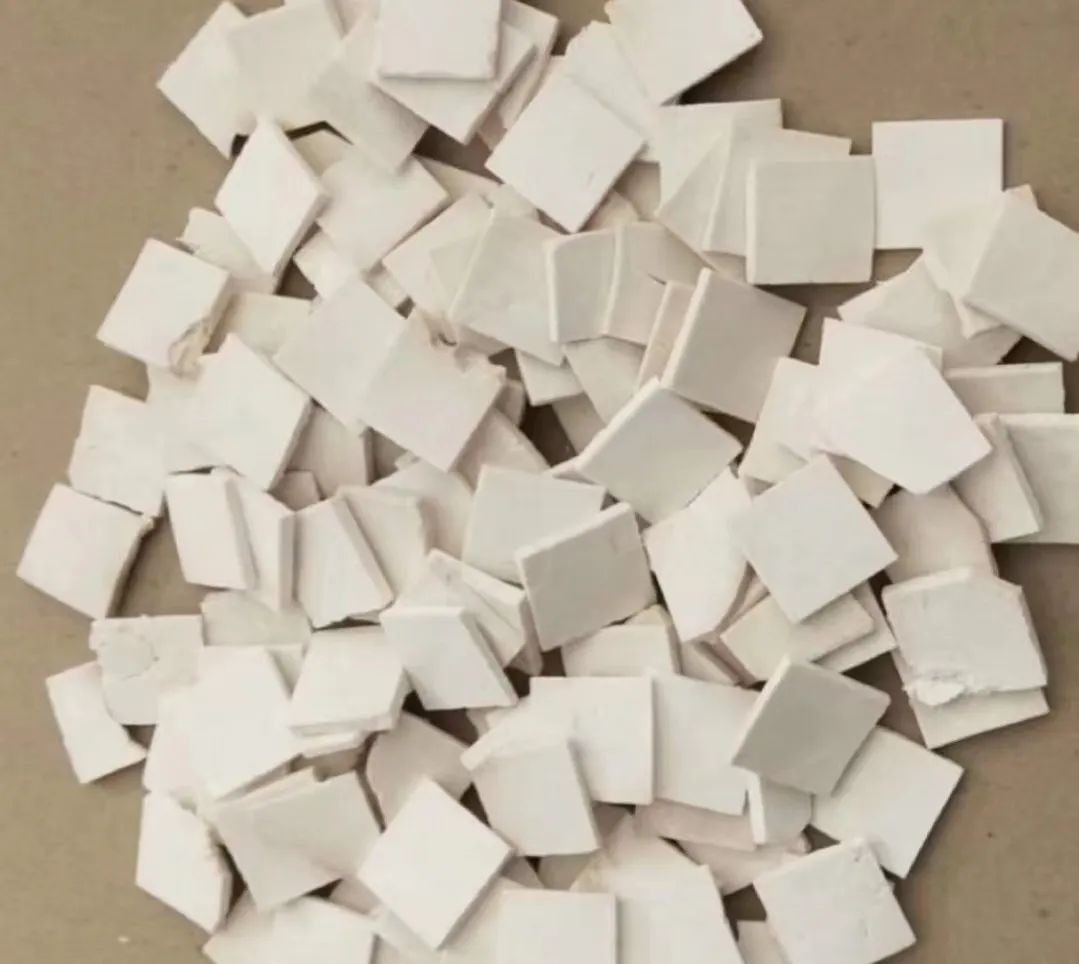 Fuling Pian (Yunnan Chuxiong)Finally, Fuling Juan is a processing method that has emerged in recent decades and is not included in the pharmacopoeia. It can only be made from fresh or frozen Fuling, which is machine-shaved and dried into a roll shape, making it fragile and less than 1mm thick.
Fuling Pian (Yunnan Chuxiong)Finally, Fuling Juan is a processing method that has emerged in recent decades and is not included in the pharmacopoeia. It can only be made from fresh or frozen Fuling, which is machine-shaved and dried into a roll shape, making it fragile and less than 1mm thick.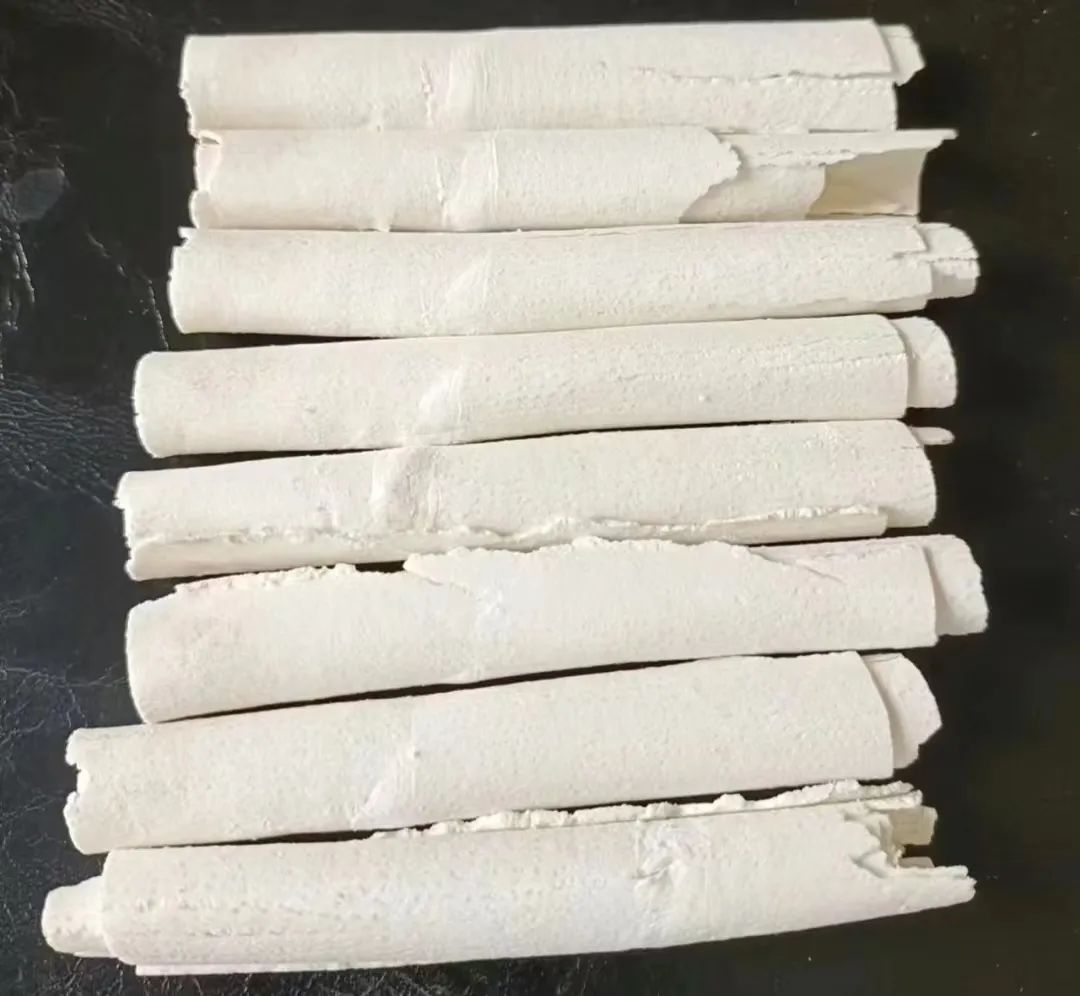 Fuling JuanThe above are the processing methods for the three specifications of Fuling. Which one is better? In terms of water permeability during decoction, Fuling Juan > Fuling Kuai > Fuling Ding, and the prices reflect this as well. Fuling Ding is the most common processing specification, and due to steaming, it becomes solid and dense, making it difficult for water to penetrate. It is possible that the decoction is ready, but the center of the Fuling remains dry, so when selecting Fuling Ding, it is best to crush it for use. Additionally, Fuling Ding dries slowly, leading to the illegal processing method of “sulfur fumigation”; Fuling is a heavy victim of sulfur fumigation. In contrast, Fuling Pian almost never undergoes sulfur fumigation, making it safer. Since Fuling Juan is very thin, it has good water permeability and is generally suitable for making tea.Now let’s talk about the classification of commonly used Fuling Ding based on the position of the material taken. Edge Ding is made from the part near the surface of Fuling, cut into cubes, usually firm in texture, irregularly shaped, resembling cubes, with uneven surface color, ranging from red to white gradient or light red to brown, occasionally with black skin, and has a bland taste, referred to as Chi Fuling.Center Ding is made from the pure white part near the center of Fuling without impurities, cut into uniformly sized cubes, firm in texture, with a white surface and a granular feel on the cross-section, and has a bland taste, referred to as Bai Fuling.Many merchants, in order to speed up the drying of Fuling and improve its appearance, often sell sulfur-fumigated edge Ding as center Ding. This type of Fuling is not much different from center Ding, but its shape is less regular, often lacking corners, and has a sour taste, with a pungent smell upon opening the bag.Whole Ding is a general term that includes both center and edge parts. It contains both unevenly colored and all-white pieces.
Fuling JuanThe above are the processing methods for the three specifications of Fuling. Which one is better? In terms of water permeability during decoction, Fuling Juan > Fuling Kuai > Fuling Ding, and the prices reflect this as well. Fuling Ding is the most common processing specification, and due to steaming, it becomes solid and dense, making it difficult for water to penetrate. It is possible that the decoction is ready, but the center of the Fuling remains dry, so when selecting Fuling Ding, it is best to crush it for use. Additionally, Fuling Ding dries slowly, leading to the illegal processing method of “sulfur fumigation”; Fuling is a heavy victim of sulfur fumigation. In contrast, Fuling Pian almost never undergoes sulfur fumigation, making it safer. Since Fuling Juan is very thin, it has good water permeability and is generally suitable for making tea.Now let’s talk about the classification of commonly used Fuling Ding based on the position of the material taken. Edge Ding is made from the part near the surface of Fuling, cut into cubes, usually firm in texture, irregularly shaped, resembling cubes, with uneven surface color, ranging from red to white gradient or light red to brown, occasionally with black skin, and has a bland taste, referred to as Chi Fuling.Center Ding is made from the pure white part near the center of Fuling without impurities, cut into uniformly sized cubes, firm in texture, with a white surface and a granular feel on the cross-section, and has a bland taste, referred to as Bai Fuling.Many merchants, in order to speed up the drying of Fuling and improve its appearance, often sell sulfur-fumigated edge Ding as center Ding. This type of Fuling is not much different from center Ding, but its shape is less regular, often lacking corners, and has a sour taste, with a pungent smell upon opening the bag.Whole Ding is a general term that includes both center and edge parts. It contains both unevenly colored and all-white pieces.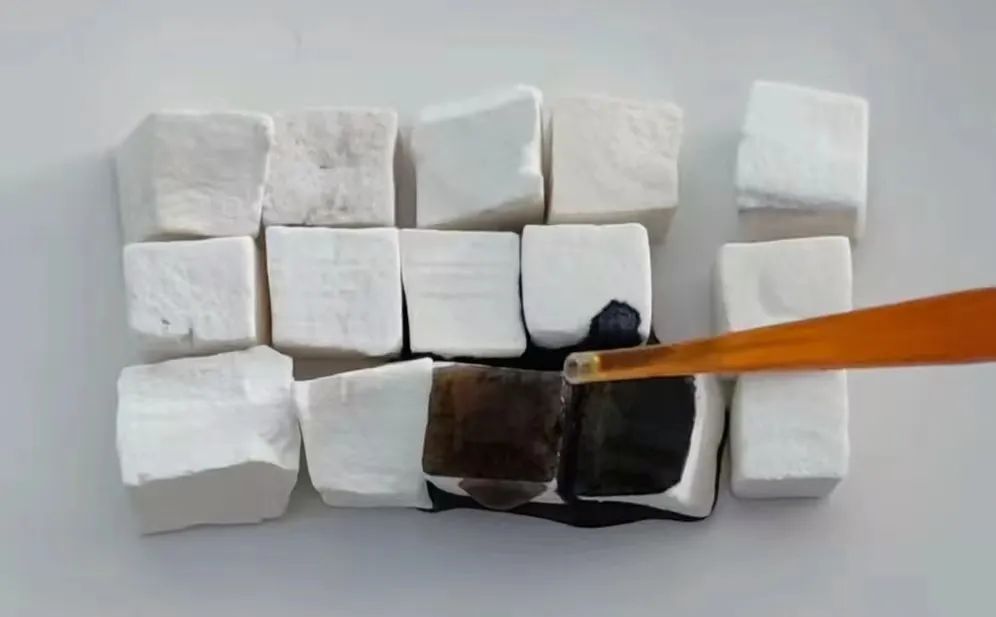 Manihot DingFuling has three counterfeit products: the first is Fen Ge (Pueraria lobata), which has a white surface, uneven and irregular stripes, is lightweight and hard, powdery, and leaves a white powder on the hand when touched, with a fibrous cross-section, initially sweet and then bitter, turning blue when exposed to iodine; the second is Cassava, which, after sulfur fumigation, has a white surface, is lightweight and hard, powdery, and leaves a white powder on the hand when touched, with a fibrous cross-section, sour taste, and turns blue when exposed to iodine; the third is cubes made from various starches, with a white surface, firm texture, strong powderiness, softening and dissolving after decoction, and turning blue when exposed to iodine. Thus, if it is a counterfeit product, it can be easily identified using iodine.Speaking of Fuling, it is worth mentioning its two related but different medicinal materials. One is Fuling Pi (the skin of Poria), which is inexpensive and currently has no known counterfeits. It appears in long strips or irregular pieces, varying in size, with a brown to black-brown outer surface, warty protrusions, a light brown inner surface, often with a white or light red subcutaneous part, relatively soft in texture, slightly elastic, with a faint aroma and bland taste.
Manihot DingFuling has three counterfeit products: the first is Fen Ge (Pueraria lobata), which has a white surface, uneven and irregular stripes, is lightweight and hard, powdery, and leaves a white powder on the hand when touched, with a fibrous cross-section, initially sweet and then bitter, turning blue when exposed to iodine; the second is Cassava, which, after sulfur fumigation, has a white surface, is lightweight and hard, powdery, and leaves a white powder on the hand when touched, with a fibrous cross-section, sour taste, and turns blue when exposed to iodine; the third is cubes made from various starches, with a white surface, firm texture, strong powderiness, softening and dissolving after decoction, and turning blue when exposed to iodine. Thus, if it is a counterfeit product, it can be easily identified using iodine.Speaking of Fuling, it is worth mentioning its two related but different medicinal materials. One is Fuling Pi (the skin of Poria), which is inexpensive and currently has no known counterfeits. It appears in long strips or irregular pieces, varying in size, with a brown to black-brown outer surface, warty protrusions, a light brown inner surface, often with a white or light red subcutaneous part, relatively soft in texture, slightly elastic, with a faint aroma and bland taste.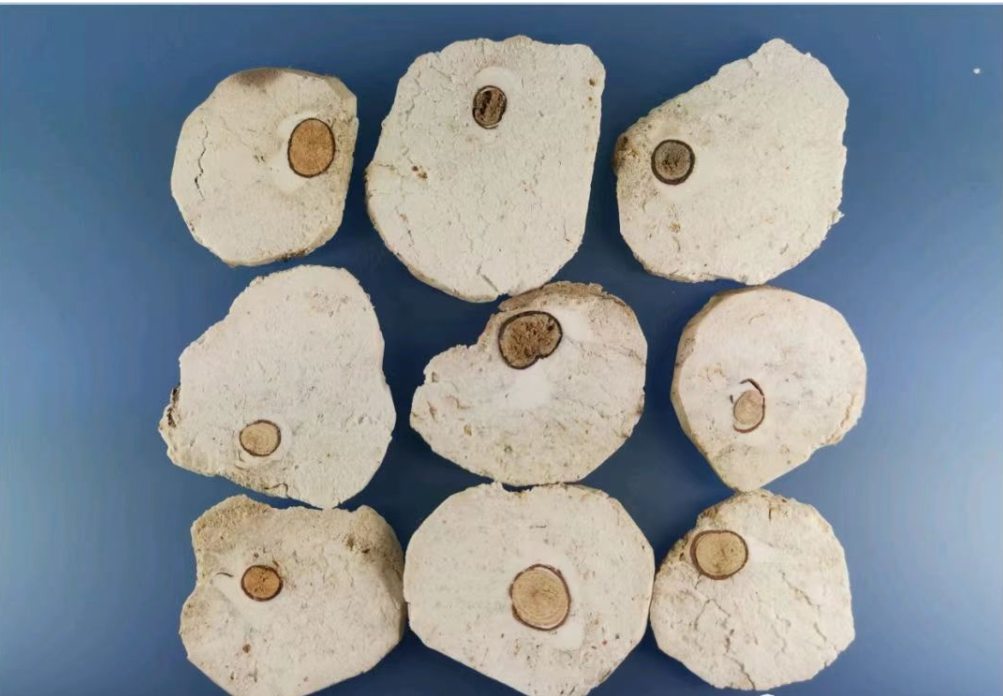 Fushen (Hunan Huaihua)Secondly, there is Fushen, which is found in wild or semi-wild Poria growing on pine roots; only wild or semi-wild Poria has a small chance of producing Fushen. Fushen is generally flat and square-shaped, with varying colors, each piece containing a pine heart, with a diameter not exceeding 15mm, and the pine root is brownish-yellow, naturally grown, with dense mycelium surrounding the Fushen.
Fushen (Hunan Huaihua)Secondly, there is Fushen, which is found in wild or semi-wild Poria growing on pine roots; only wild or semi-wild Poria has a small chance of producing Fushen. Fushen is generally flat and square-shaped, with varying colors, each piece containing a pine heart, with a diameter not exceeding 15mm, and the pine root is brownish-yellow, naturally grown, with dense mycelium surrounding the Fushen.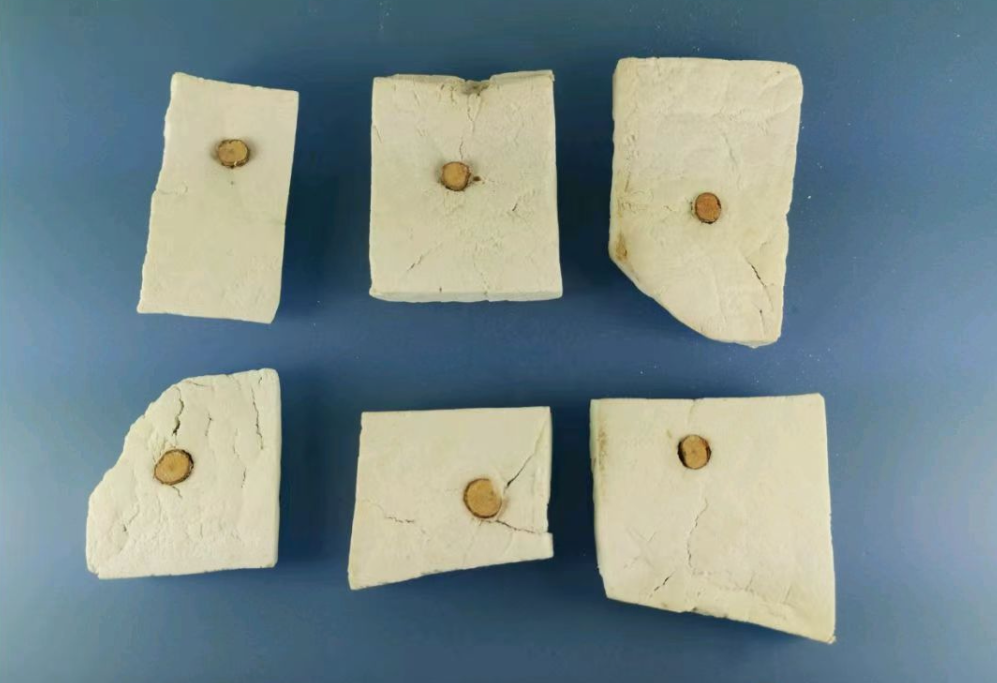 Counterfeit FushenCounterfeit Fushen is made by inserting pine branches or blocks into the sclerotium before cutting fresh Fuling, and after drying, it is sliced. The Fushen wood surrounding the Fuling appears white, with no dense mycelium surrounding it, and the Fushen wood is hard, easily movable, and prone to falling off when pushed.Fushen wood can be made from dead pine roots that have grown Fuling or from wild-grown dead pine roots. Fushen wood appears curved like pine roots, decayed wood-like, with residual Fushen appearing white or grayish-white on the outside, and woody on the inside, soft in texture, lightweight, and bland in taste.
Counterfeit FushenCounterfeit Fushen is made by inserting pine branches or blocks into the sclerotium before cutting fresh Fuling, and after drying, it is sliced. The Fushen wood surrounding the Fuling appears white, with no dense mycelium surrounding it, and the Fushen wood is hard, easily movable, and prone to falling off when pushed.Fushen wood can be made from dead pine roots that have grown Fuling or from wild-grown dead pine roots. Fushen wood appears curved like pine roots, decayed wood-like, with residual Fushen appearing white or grayish-white on the outside, and woody on the inside, soft in texture, lightweight, and bland in taste.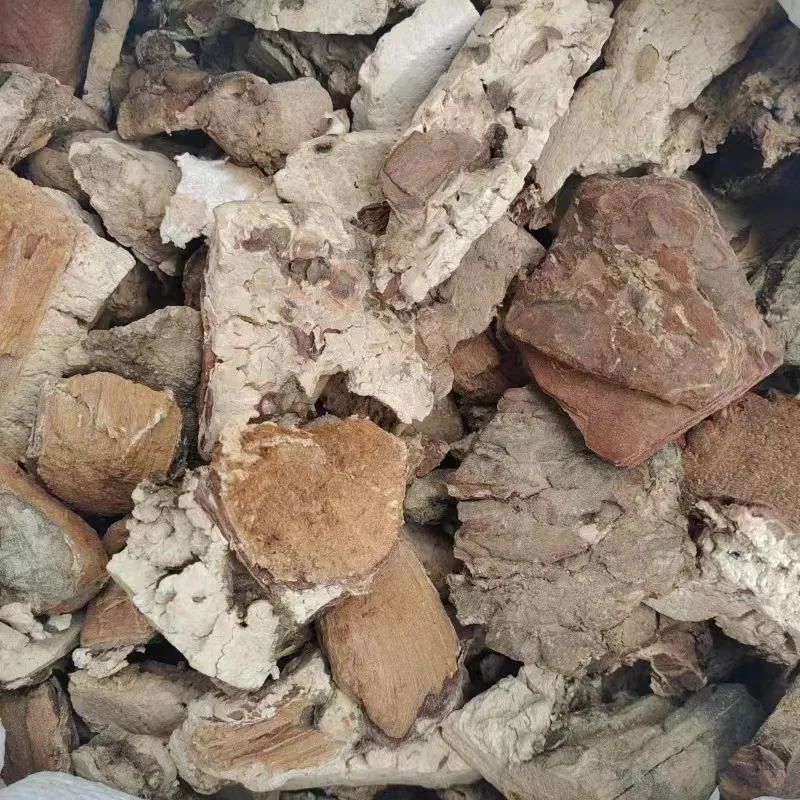 Fushen WoodFinally, let’s discuss the differences in efficacy. As mentioned earlier, the efficacy of Fuling is to promote diuresis and drain dampness, while Fuling Pi is good at promoting diuresis and draining dampness, primarily treating edema, often used for facial edema. Chi Fuling inherits the characteristics of Fuling Pi, excelling in promoting diuresis and draining dampness, primarily treating lower limb edema. Fushen is better than Fuling at calming the mind and can be used for palpitations and insomnia. Fushen wood enters the liver meridian, can calm the liver and mind, and is used for insomnia caused by excessive liver fire.In the next issue, we will discuss the common syndromes treated with Fuling, so remember to follow us!More TCM KnowledgeJoin the “Yang Dad’s TCM Health Exchange Group”Scan to reply “Join Group”
Fushen WoodFinally, let’s discuss the differences in efficacy. As mentioned earlier, the efficacy of Fuling is to promote diuresis and drain dampness, while Fuling Pi is good at promoting diuresis and draining dampness, primarily treating edema, often used for facial edema. Chi Fuling inherits the characteristics of Fuling Pi, excelling in promoting diuresis and draining dampness, primarily treating lower limb edema. Fushen is better than Fuling at calming the mind and can be used for palpitations and insomnia. Fushen wood enters the liver meridian, can calm the liver and mind, and is used for insomnia caused by excessive liver fire.In the next issue, we will discuss the common syndromes treated with Fuling, so remember to follow us!More TCM KnowledgeJoin the “Yang Dad’s TCM Health Exchange Group”Scan to reply “Join Group” Author | Wang KunEditor | Zeng JuImages | Midjourney/Stock Photo Network (Copyright Purchased)Follow the 【Chengdu Yang Dad TCM Clinic】 WeChat Official Account,Reply “TCM Dietary Therapy”to receive the e-book “TCM Dietary Therapy”
Author | Wang KunEditor | Zeng JuImages | Midjourney/Stock Photo Network (Copyright Purchased)Follow the 【Chengdu Yang Dad TCM Clinic】 WeChat Official Account,Reply “TCM Dietary Therapy”to receive the e-book “TCM Dietary Therapy”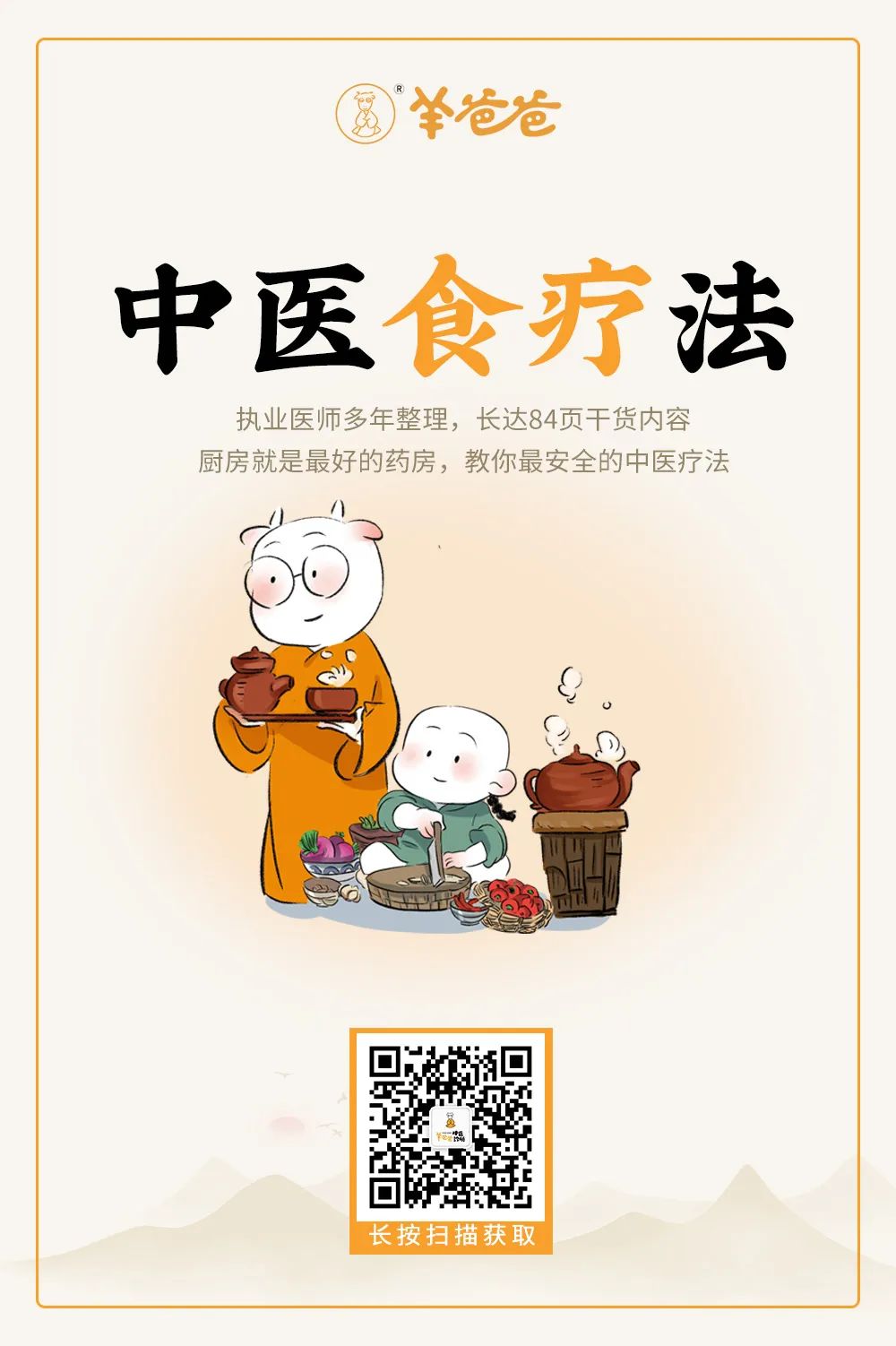 Long press the QR code in the image to obtain “TCM Dietary Therapy”
Long press the QR code in the image to obtain “TCM Dietary Therapy” For online consultation, please scan the 【Online Consultation】 QR code to contact online customer service.If you like it,reward Yang Dad with a “👍” and “Looking”
For online consultation, please scan the 【Online Consultation】 QR code to contact online customer service.If you like it,reward Yang Dad with a “👍” and “Looking”
